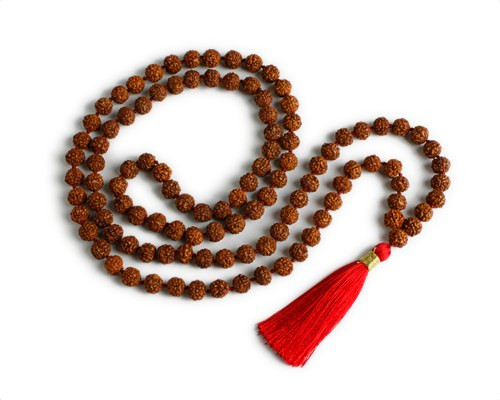Many yoga practitioners use a garland of mala beads for repetition of a mantra. This practice, known as Japa in Sanskrit, is a form of meditation that calms and focuses the mind while inviting the vibration of the mantra to do its healing work on the subtle body. So, in addition to developing greater concentration and inner stillness, in Japa meditation we benefit energetically from these ancient sacred Sanskrit sounds.
A full mala has 108 strung beads for counting (similar to a Catholic rosary), plus one “guru bead” that is connected to a tassel.
There are also wrist malas which have 27 beads, and one can use them the same way, cycling through the garland four times to equal 108 repetitions.
The significance of the number 108 is open to interpretation, but has long been considered a sacred number in Hinduism, Buddhism and yoga. Ancient Vedic mathematicians viewed 108 as a number of the wholeness of existence. This number also connects the Sun, Moon, and Earth: The average distance of the Sun and the Moon to Earth is 108 times their respective diameters. And, according to yogic tradition, there are 108 pithas, or sacred sites, throughout India. And there are also 108 Upanishads and 108 marma points, or sacred places of the body.
For more on the significance of108, click here.
How to do Japa:
1. Sit comfortably with your spine elongated and your eyes closed. Take a few deep breaths to center and align yourself with your intention.
2. If you have one, use a mantra for this practice, chanting aloud or silently.
3. Hold your mala in your right hand, draped over your middle finger. Starting next to the guru bead, use your thumb to count each bead, pulling it toward you as you recite your mantra. Do this 108 times, traveling around the mala, until you once again reach the guru bead.
4. Do not count or pass over the guru bead. If you want to continue the meditation and do more cycles of 108 repetitions, simply reverse direction and begin again.
5. When your mantra repetitions are complete, pause for a few moments in stillness to notice the effects and benefits of Japa meditation.
Some common, simple Sanskrit mantras:
OM: The primordial sound of the Universe
Om Gam Ganapataye Namaha: I honor Ganesha, the Lord of beginnings and Remover of obstacles
OM Namah Shivaya: I bow to Shiva, the Divinity Within
OM Namo Bhagavate Vasudevaya:I bow to the Beloved Divine Presence that lives in the hearts of all beings.
Om Mani Padme Hum: Behold the jewel in the lotus
Aham Prema:I am Divine Love
Ram:(a name for God)
Lokah Samasta Sukhino Bhavantu:May all beings everywhere be happy and free
You can also use mantras from other faith traditions and languages, if Sanskrit feels too unfamiliar to you. Try working with “Thy will be done,” “I am that I am,” “Kyrie Eleison,” “Shalom,” or any liturgical phrase that connects you with a sense of peace and Divine Presence. Use whatever works for you. Your sense of devotion is what gives the practice its power.
It is recommended to work with a chosen mantra for a period of time (such as 40 days) to fully experience how a particular mantra affects you vibrationally. Pay attention and notice the internal changes in mood, energy and attitude, as well as the shifts in your life situation with regard to money, relationships, health, work, and more. Mantras are powerful medicine!




